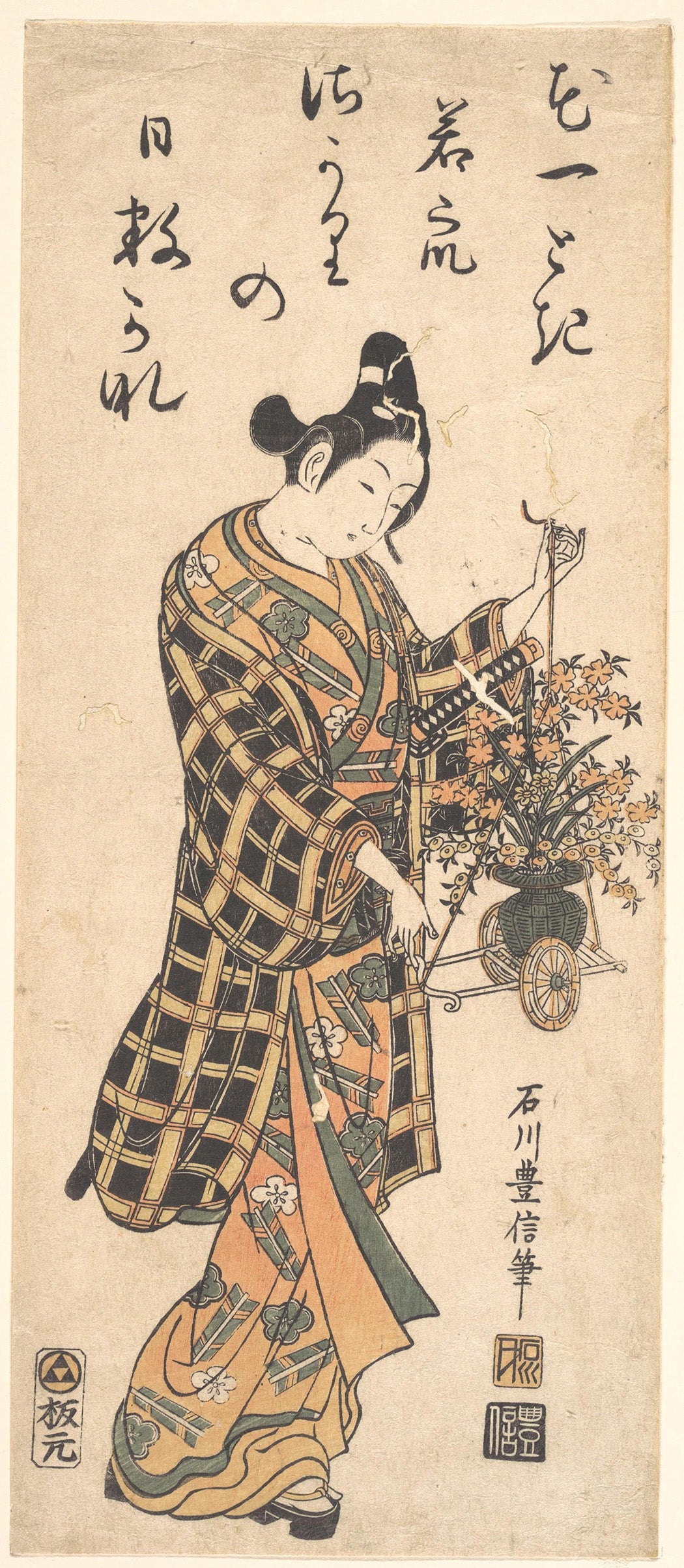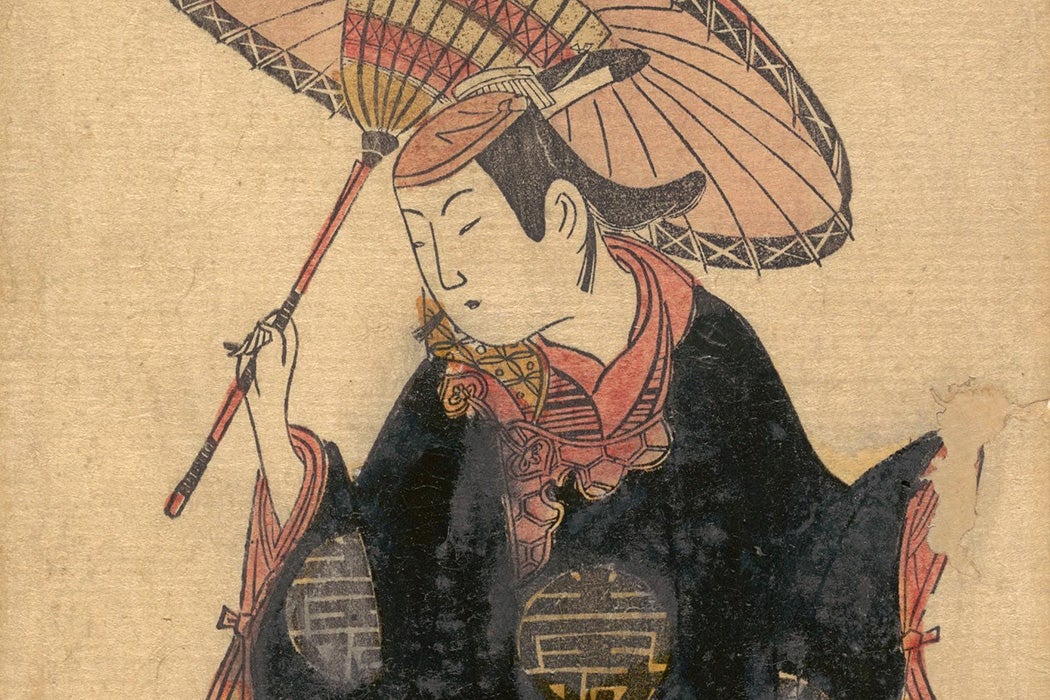Looks matter. Hairstyles, clothes, even movements and body language construct our identities, mark our social class, give hints about our group membership. Perhaps most obviously, our hair and clothes are often an expression of our gender.
Audio brought to you by curio.io
What holds true today was also the case in pre-modern Japan. As the historian Gregory Pflugfelder observes, Edo Japan (1603-1867) was governed by strict rules on what hairstyles, clothes, and weapons could be worn by which gender, age, and social group. More than social conventions, some of these regulations were even enshrined in law. Clothes and hair expressed their wearer’s gender, with specific styles worn exclusively by men or women. However, gender roles in Edo Japan went beyond the dichotomy of male and female to include what is often referred to as a “third gender:” the Wakashu.
Wakashu were, broadly speaking, male youths transitioning between being a child and an adult. But they were also more than just young men, occupying their own singular space with unique rules, conventions and, most crucially, their own style. Indeed, Wakashu were identified primarily through their clothes and hairstyles. They wore their hair in a topknot, with a small, shaved portion at the crown of the head and long forelocks at the sides, as opposed to adult men, who shaved the entire crown of their heads. Wakashu clothes were similar to those worn by unmarried young women: colorful kimonos with long, flowing sleeves.
Wakashu usually ranged between seven to early twenties in age. However, “youth” in Edo Japan must be understood as a more fluid term, one that is not connected solely to biological age. Often the family—or the young boy himself—could decide on the beginning and end of the Wakashu phase. Practically every Japanese male went through a Wakashu stage, which ended with a coming-of-age ceremony called genpuku, denoted by changes in clothing and hairstyle. After this ceremony, they would take up their roles as men in society. However, some chose to delay their coming-of-age ceremony beyond their twenties or to remain a Wakashu for large parts of their lives.
Weekly Newsletter
Wakashu were connected to sexuality. As youth, they were considered largely free from the burdens and responsibilities of adulthood but regarded as sexually mature. As an object of desire for men and women, they had sex with both genders. The intricate social rules that governed the appearance of Wakashu also regulated their sexual behavior. With adult men, Wakashu assumed a passive role, with women, a more active one. Relationships between two Wakashu were not tolerated. Any sexual relationship with men ended after a Wakashu completed his coming-of-age ceremony.
Their most important relationship would be with an older man, which often had both a sexual and a teacher-student element. This was termed Shudō, literally the way of the youth, and a way for younger men to grow into the world through the guidance of a more experienced adult. Contemporary sources sometimes speak of the relation between a Wakashu and his older partner as lifelong bond.
Gender fluidity in Edo Japan had its limits. Wakashu were always biologically male. Women could dress up like a Wakashu, but they did not enjoy the same sexual liberties, although depictions of female prostitutes dressing like Wakashu to attract customers of both sexes survived.

Their youth, elaborate clothes, and connection to sexuality made Wakashu a popular motif of ukiyo-e woodblock prints. These “images from a floating world” were a mass medium, designed not for the higher classes, but for the increasing middle class. Their subject matter often veered between the erotic and the pornographic. Ukiyo-e, populated by dashing Kabuki actors, beautiful courtesans, sensual prostitutes, or heroic Samurai, often depict the pleasure and entertainment quarters of Edo Japan in head-spinning details and colors. These depictions showed Wakashu engaging in seemingly innocent pastimes, such as playing instruments and taking a stroll, as well as in sexual acts with both men and women.
A range of Wakashu images survived, although casual viewers today would most likely have trouble identifying them as such. Long-sleeved kimonos, elaborate poses, and sensuous facial expressions can be found among images of both Wakashu and women, and it is almost impossible to distinguish a Wakashu from a courtesan—or indeed any young lady. Often, it is only their hairstyle that differentiates them. The prevalence of Wakashu in the woodblock prints speaks to their integral role in Japanese society.
By the second half of the nineteenth century, Wakashu had effectively disappeared. What happened? Beginning in 1635, Japan had followed a strict seclusion policy known as sakoku. For two centuries, the country had been almost totally isolated from the world, and so a distinctive Japanese culture with its own moral and sexual codes developed and thrived. This seclusion ended in 1854 when the black ships of the US Commodore Matthew Perry arrived in Edo Bay to negotiate treaties that would result in the opening of the country to Western trade and influences.
Perry’s black ships were the trigger for unparalleled changes in virtually all areas of Japanese society, culminating in the creation of a centralized Japanese nation-state under the Meiji emperor in 1868. In the span of a few decades, Japan saw an unequalled influx of Western ideas and people, while at the same time Japanese people were sent to Europe and the United States to bring back knowledge in the areas of science, economics, politics, the military, and medicine. With breath-taking speed, Japan transformed from a feudal state into a modern nation. Crucially, Japan did not only import Western technology, but also Christian and Victorian morals and ethics. With Western norms and values came the prevalence of a strict male-female dichotomy.
Pflugfelder writes that, in the years following the establishment of the new Japanese nation-state, sex and gender, not class, became the defining factors in establishing an individual’s role in society. Gender equalled physiological sex and two distinct spheres, “masculine” and “feminine,” were created and rigorously maintained. The policies of the Meiji Government reinforced the connection between masculinity, national power, and modernity, going so far as to regulate dress and hair. In 1871, for instance, men were fined if they did not follow the newly-mandated close-cropped haircut, and, from 1872 onwards, women were forbidden by law to wear their hair short. For a Wakashu, hairstyle was an important marker of identity and a signal of their special status to the outside world. However, under the new rules, all men in Japan had to wear a similar haircut. Hair still signalled gender identity; now, however, that identity was firmly male or female.
Around that time, women’s kimonos became the symbol of a traditional and uniquely Japanese dress, which stood in opposition to the Western clothes that men were encouraged to wear, which symbolized modernity. Through a range of policies, the government attempted to remove women from traditionally female industries such as silk production, measures designed to associate femininity with the home and masculinity with the realm of the public. In 1873, a legal code in Tokyo explicitly forbade men and women to cross-dress. It became illegal for Wakashu to wear the same clothes as young women, thereby erasing their second marker of identity.
In addition, age also became standardized with legal definitions of categories such as “child,” “youth,” and “adult.” Standard definitions of age and gender made it easier to integrate individuals into the nation-state and to assign them fixed roles and spheres, such as domestic work and child rearing for women and military service for men. While in Edo Japan, the individual or their family could determine the beginning and the end of the youth phase, the state now had strong power and control over its citizens, their development, and their gender roles.

These strict gender hierarchies and age restrictions left no space for the fluidity of Wakashu, who were either ridiculed, condemned, or ignored. The more open sexual behavior codes that defined feudal Japan had no place in the new nation-state. Without their distinct hairstyles and clothes and faced with a strict moral code, Wakashu effectually ceased to exist as a “third gender.”
The same connection between nationalism and gender that proved fatal to the Wakashu continues today. The surge of nationalist tendencies around the globe often goes hand in hand with a tightening of gender norms and a policing of gender expression. It is no accident that in September 2021, the Chinese government released new regulations, banning “effeminate” men from TV and media to promote an image of aggressive masculinity. These rules are meant to enforce a “correct” masculinity and to promote “traditional” Chinese, revolutionary, and socialist culture. The ban coincides with a rise of nationalistic ideals and a tightening of social and economic controls by the Chinese government.
The connection between nationalism and masculinity is not confined to Asia. Since it came to power in 2015, the right-wing populist Law and Justice party in Poland has increased its political assaults on the rights of women and LGBTQ+ people, while strengthening nationalist views and ideologies. Likewise, gender identity and expression remain contested in Western states. When the singer Harry Styles, for instance, appeared in a dress on the cover of Vogue in fall 2020, the photos prompted calls for a “return to manly men” from right-wing and nationalist news sources and pundits.
Multifaceted gender expressions and LGBTQ+ rights are constantly negotiated and contested. While in recent decades, gender definitions and LGBTQ+ rights have expanded in many parts of the world, Wakashu illustrate how quickly more open and fluid understandings of gender and sex can be repressed and erased.
Support JSTOR Daily! Join our new membership program on Patreon today.







